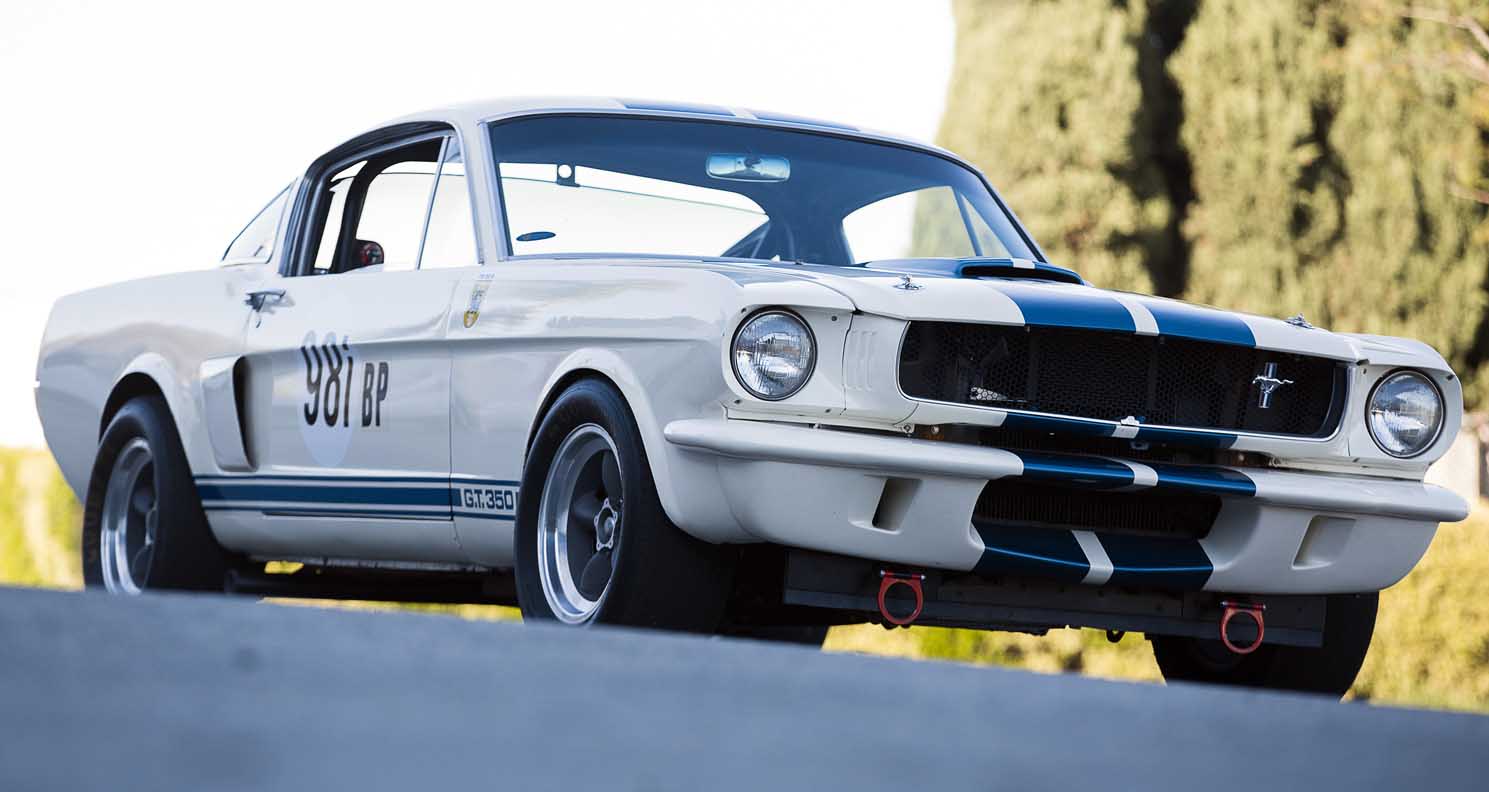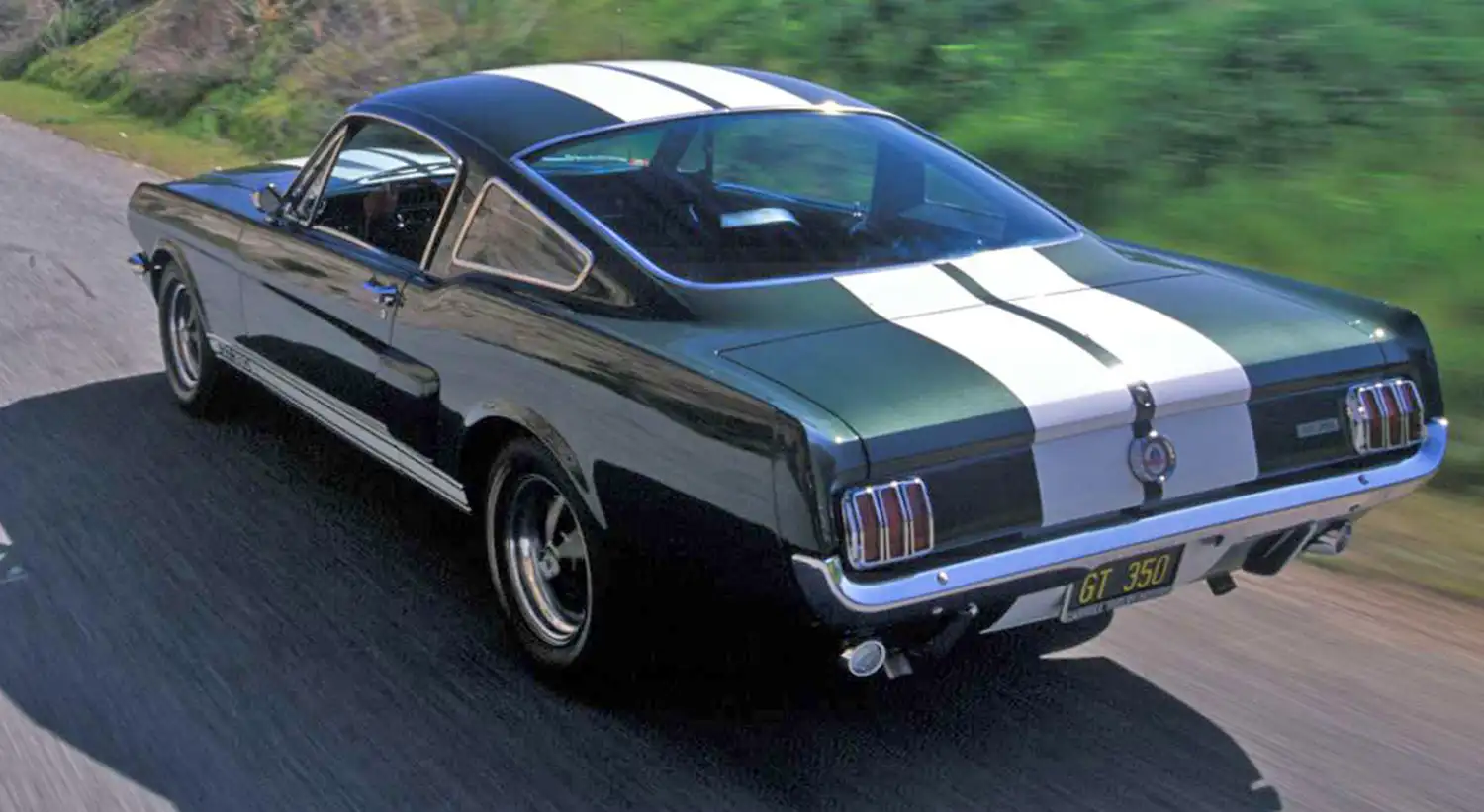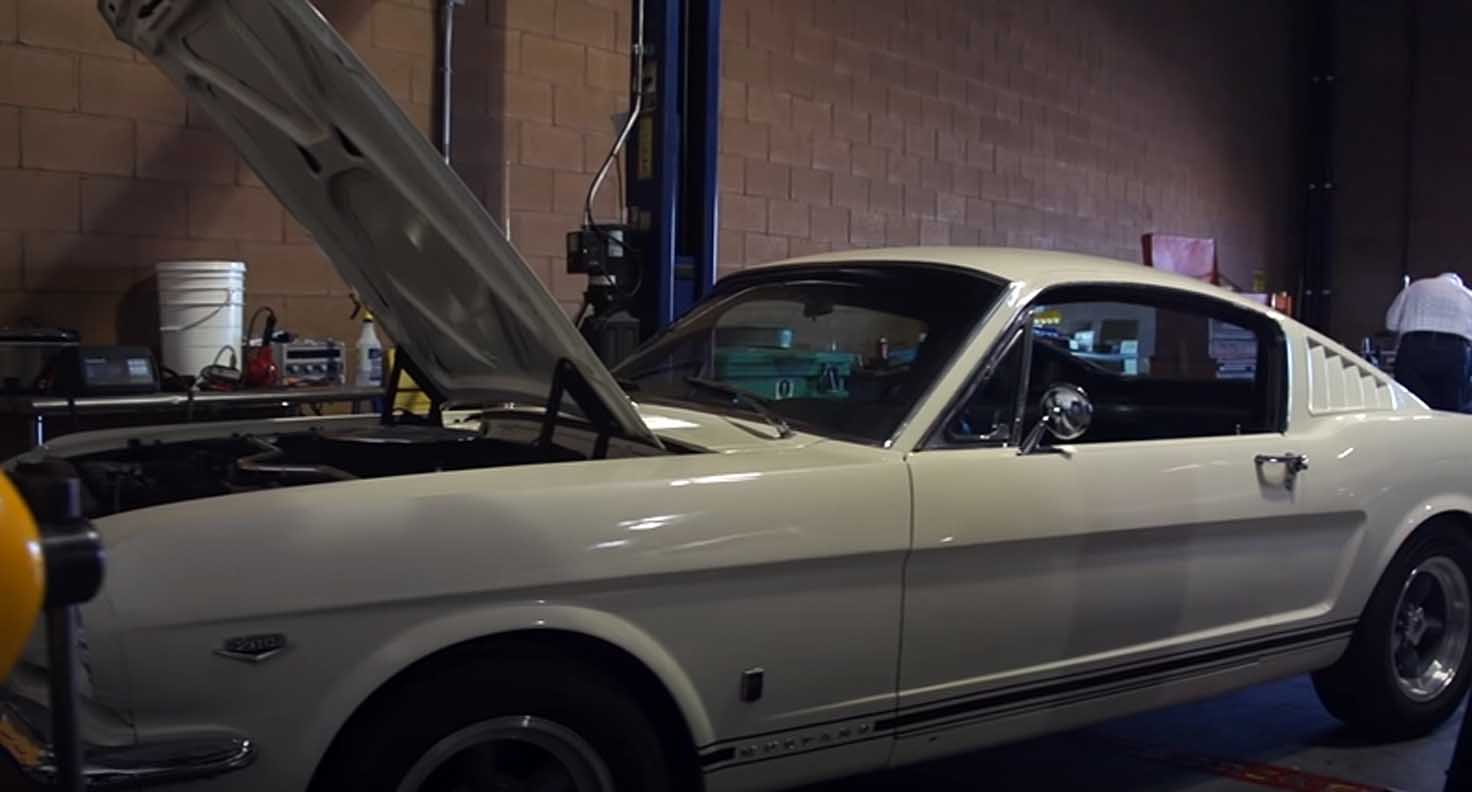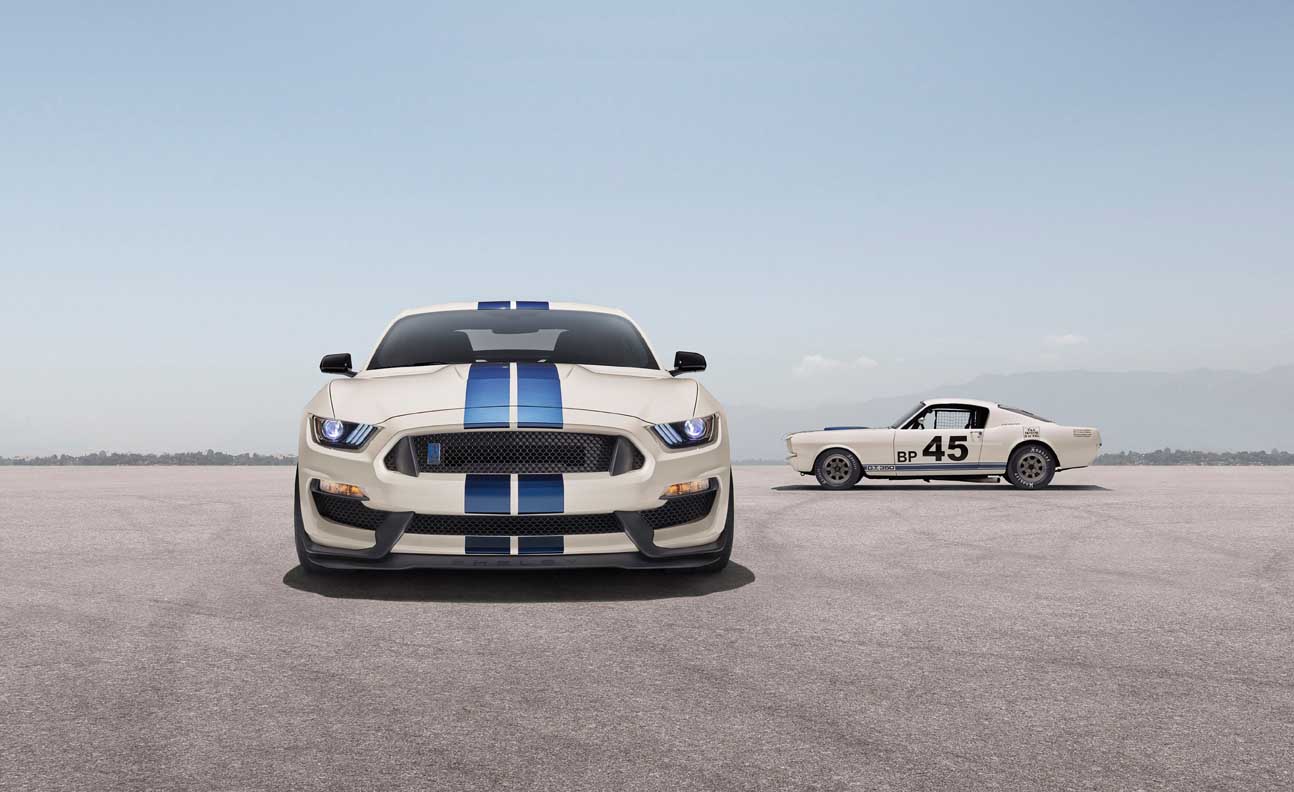
The 1965-1966 cars were the smallest and lightest of the GT 350 models. These cars are often called “Cobras”, which was the Ford-powered AC-based two-seat sports car also produced by Shelby American during the same period. Both models use the Cobra emblem, similar paint scheme, and the optional “Cobra” valve covers on many GT350s that were part of a marketing tie-in by Shelby, as well as one of his iconic symbols. All 1965-66 cars featured the K-Code 271 hp (202 kW; 275 PS) 289 cu in (4.7 L), modified to produce 306 hp (228 kW; 310 PS). Marketing literature referred to this engine as the “Cobra hi-riser” due to its high-riser intake manifold. Beginning as a stock Mustang with a 4-speed manual and 9″ live rear axle, the cars were shipped to Shelby American, where they received the high-riser manifolds, Tri-Y headers, and were given larger Ford Galaxie rear drum brakes with metallic-linings and Kelsey-Hayes front disc brakes.
The 1965 G.T. 350 was not built for comfort or ease of driving. There were 34 “G.T. 350R” race-spec cars built specifically for competition use under SCCA rules, and the model was the B-Production champion for three straight years. The 1966 G.T. 350 had featured more comfort of casual drivers that included rear seats, optional colors, and an optional automatic transmission. This trend for additional features continued in following years, with the cars becoming progressively larger, heavier, and more comfortable, while losing much of their competitiveness in the process. The 1969 G.T. 350s and 500s were largely styling modifications to a stock Mustang. By 1969 Carroll Shelby was no longer involved in the Shelby GT program, and the design was done in-house by Ford.

The 1965 and 1966 G.T. 350s were delivered from Ford’s San Jose assembly plant in body in white form for modification by Carroll Shelby’s operation, originally in Venice Beach and later at Los Angeles International Airport. San Jose cars carried an “R” in the Ford VIN denoting that facility. The only year that Shelby Mustangs from the 1960s came from another plant was 1968, where they came from New Jersey, “T” in the VIN, and were modified by A.O. Smith.
1965
All 1965 G.T. 350s were painted Wimbledon White with Guardsman Blue rocker stripes. Very few GT350s were delivered to the dealer with the optional “Le Mans” (or “LeMans”) top stripes, which run the length of the entire car. Approximately 28% of the 562 1965 cars built had Le Mans stripes. Dealers often added the stripes, probably at the customer’s request. Today, it is difficult to find a GT 350 not so equipped.
Many ERT 1965 cars had the battery relocated to the trunk, which was changed mid-year from complaints of fumes, and featured over-rider traction bars, relocated A-arms, as well as other modifications. Over-rider traction bars are named so because of their design being on top of the leaf spring as opposed to underneath them. There was only one transmission available, a 4-speed Borg-Warner T-10 manual. The exhaust system in the 1965 G.T. 350 was a side-exit dual exhaust with glass-pack mufflers. For this one year, the G.T. 350 also featured special 130 mph-rated Goodyear “Blue Dot” tires, named for the prominent blue dot on each sidewall. The 1965 G.T. 350 had a full size spare tire mounted in place of rear seats, making it a 2-seat-only vehicle (to be allowed to race under SCCA regulations as a “sports car”), and rode on either silver-painted steel wheels or special cast-magnesium center “Cragar Shelby” 15″ rims with chromed center caps marked with a stylized “CS”. Total 1965 model year production was 562 units.

1966
For 1966, the GT 350 lost its Mustang tag and was marketed simply as the Shelby GT 350. The new model year also saw the introduction of non-white colors, including blue, red, green, and black. Other changes included special rear quarter-panel windows replacing the factory extractor vents, functional brake scoops on each side, and optional SelectShift 3-speed automatic, as well as an optional Paxton supercharger. The battery was no longer relocated to the trunk for 1966, and the over-rider traction bars were discontinued. The normal factory fold-down rear seat was optional. While early 1965 cars had black engine blocks, 1966 and later cars had their engines painted the regular factory Ford dark blue. The 1966 models came with a dual-exhaust exiting in the rear.
The first 252 GT 350s for 1966 began as 1965 Mustang K-Code Fastbacks. These cars were specifically ordered by Shelby American for conversion into 1966 GT 350s. Upon delivery to Shelby-American, the cars were randomly picked for conversion. The Shelby VINs do not correspond in numerical order with Ford VINs. The Ford VINs were shipped in ‘blocks,’ but many differ significantly because the order they were taken for conversions.
Total production for 1966 was 1,373 fastbacks, including two prototypes and four drag cars, and the 252 early production models with Ford Mustang 1965 bodies. The Hertz rental company ordered 1,003 fastbacks, including two prototypes. Four convertibles were also produced, for a total of 2,378 units for 1966. A small number of the 1966 models were fitted from the factory with Paxton superchargers, but not the No-Spin limited slip differential; with an option price of US$670, the engine was rated at 440 hp (330 kW).

1966 Shelby G.T.350 Hertz models
Shelby struck a deal with the Hertz Corporation to produce a special line of G.T. 350s for rent that, after their rental-car lives were finished, were returned to Ford, refurbished, and sold to the public as “GT 350-H” models. Most Hertz cars featured gold LeMans stripes and rocker panel stripes, although a few were white with blue stripes. The first 85 Hertz cars were available with four-speed manual transmissions and Hertz advertised them as “Rent-a-Racer” cars. During rental, these cars were sometimes used as production class cars at SCCA events, and were rumored to have been returned to Hertz with evidence of roll bars being welded in. Hertz ordered the last 800 models with black paint, gold stripes and black interior, as well as automatic transmissions.
When the Hertz cars were returned to Ford to be prepared for sale to the public, the high-performance parts were often “lost” (presumably at the manufacturer) before final sale.
Source: Wikipedia (GNU Free Documentation License)
























The post 1965 Ford Mustang Shelby GT350 appeared first on Wheelz.me-English.




